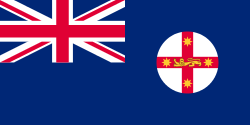Colony of New South Wales
| New South Wales Colony | |||||
| British Crown Colony | |||||
| |||||
|
| |||||
| Government | Self-governing colony | ||||
| Monarch | |||||
| • | 1788–1820 | George III first | |||
| • | 1855–1900 | Victoria last | |||
| Governor | |||||
| • | 1788–1792 | Arthur Phillip first | |||
| • | 1899–1900 | William Lygon, 7th Earl Beauchamp last | |||
| Legislature | Parliament of New South Wales | ||||
| History | |||||
| • | Established | 1788 | |||
| • | Independence of Van Diemen's Land | 3 December 1825 | |||
| • | Independence of the South Australia Colony | 28 December 1836 | |||
| • | Independence of the Colony of New Zealand | 1 July 1841 | |||
| • | Independence of the Queensland Colony | 6 June 1849 | |||
| • | Independence of the Victoria Colony | 1 July 1851 | |||
| • | Federation of Australia | 1900 | |||
The colony of New South Wales was a colony of the British Empire from 1788 to 1900, when it became a State in the federal Commonwealth of Australia on 1 January 1901. At its greatest extent, the colony of New South Wales included the present-day Australian states of New South Wales, Queensland, Victoria, Tasmania, South Australia, and New Zealand. The first "responsible" self-government of New South Wales was formed on 6 June 1856 with Sir Stuart Alexander Donaldson appointed by Governor Sir William Denison as its first Colonial Secretary which in those days accounted also as the Premier.[1]
History
Formation
On 18 January 1788, the First Fleet led by Captain Arthur Phillip founded the first British settlement in Australian history as a penal colony. Having set sail on 13 May 1787, Captain Arthur Phillip assumed the role of governor of the settlement upon arrival, until 1792.
Separation of Van Diemen's Land
Major-General Ralph Darling was appointed Governor of New South Wales in 1825, and in the same year he visited Hobart Town, and on December 3 proclaimed the establishment of the independent colony, of which he was actually Governor for three days.
Separation of South Australia
In 1834, the British Parliament passed the South Australia Act 1834, which enabled the province of South Australia to be established.
Separation of New Zealand
On 16 November 1840, the British government issued the Charter for Erecting the Colony of New Zealand. The Charter stated that the Colony of New Zealand would be established as a Crown colony separate from New South Wales on 1 July 1841.[2]
Separation of Victoria
On 1 July 1851, writs were issued for the election of the first Victorian Legislative Council, and the absolute independence of Victoria from New South Wales was established proclaiming a new Colony of Victoria.
Separation of Queensland
A public meeting was held in 1851 to consider Queensland's proposed separation from New South Wales. On 6 June 1859, Queen Victoria signed Letters Patent to form the separate Colony of Queensland. Brisbane was named as the capital city. On 10 December 1859, a proclamation was read by British author George Bowen, whereby Queensland was formally separated from the state of New South Wales.[3] As a result, Bowen became the first Governor of Queensland. On 22 May 1860 the first Queensland election was held and Robert Herbert, Bowen's private secretary, was appointed as the first Premier of Queensland. Queensland also became the first Australian colony to establish its own parliament rather than spending time as a Crown Colony.
See also
References
- ↑ Government Gazette June 1856
- ↑ Moon, Paul (2010). New Zealand Birth Certificates – 50 of New Zealand's Founding Documents. AUT Media. ISBN 9780958299718.
- ↑ "Q150 Timeline". Queensland Treasury. Retrieved 28 October 2011.
